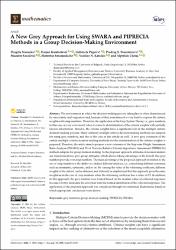| dc.description.abstract | The environment in which the decision-making process takes place is often characterized
by uncertainty and vagueness and, because of that, sometimes it is very hard to express the criteria
weights with crisp numbers. Therefore, the application of the Grey System Theory, i.e., grey numbers,
in this case, is very convenient when it comes to determination of the criteria weights with partially
known information. Besides, the criteria weights have a significant role in the multiple criteria
decision-making process. Many ordinary multiple criteria decision-making methods are adapted
for using grey numbers, and this is the case in this article as well. A new grey extension of the
certain multiple criteria decision-making methods for the determination of the criteria weights is
proposed. Therefore, the article aims to propose a new extension of the Step-wise Weight Assessment
Ratio Analysis (SWARA) and PIvot Pairwise Relative Criteria Importance Assessment (PIPRECIA)
methods adapted for group decision-making. In the proposed approach, attitudes of decision-makers
are transformed into grey group attitudes, which allows taking advantage of the benefit that grey
numbers provide over crisp numbers. The main advantage of the proposed approach in relation to the
use of crisp numbers is the ability to conduct different analyses, i.e., considering different scenarios,
such as pessimistic, optimistic, and so on. By varying the value of the whitening coefficient, different
weights of the criteria can be obtained, and it should be emphasized that this approach gives the same
weights as in the case of crisp numbers when the whitening coefficient has a value of 0.5. In addition,
in this approach, the grey number was formed based on the median value of collected responses
because it better maintains the deviation from the normal distribution of the collected responses. The
application of the proposed approach was considered through two numerical illustrations, based on
which appropriate conclusions were drawn. | tr |















